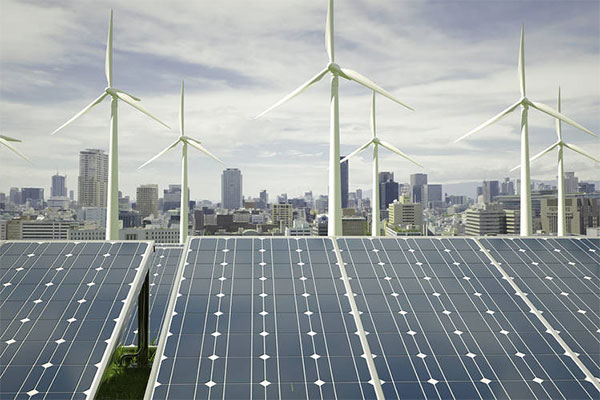Washington DC – According to a review by the SUN DAY Campaign of data recently released by the Federal Energy Regulatory Commission (FERC), wind and solar resources have provided nearly all (99.63%) of the new electrical generating capacity added in the U.S. during the first two months of 2021.
FERC’s latest monthly “Energy Infrastructure Update” report (with data through February 28, 2021) reveals that nine “units” of new wind (2,263-MW) and 65 units of new solar (1,516-MW) accounted for all but 14-MW of the capacity added in January and February. Natural gas provided 9-MW and hydropower added 5-MW. All of the new capacity reported for the month of February was from wind (968-MW) and solar (589-MW).
Utility-scale renewable energy facilities collectively now account for 24.55% of the nation’s total available installed generating capacity [1] and continue to expand their lead over coal (19.30%) and nuclear power (8.50%). The generating capacity of just wind (10.11%) is now more than a tenth of the nation’s total while wind and solar combined account for 14.72% … and that does not include distributed (e.g., rooftop) solar. [2]
In fact, FERC data suggest that renewables’ share of generating capacity is on track to increase significantly over the next three years (i.e., by February 2024). “High probability” generation capacity additions for wind, minus anticipated retirements, reflect a projected net increase of 21,628-MW while solar is foreseen growing by substantially more – 38,785MW. Hydropower is also projected to experience growth (900-MW), while biomass and geothermal may dip by 213-MW and 2-MW respectively.
On the other hand, the generating capacities of coal and oil are projected to plummet – by 24,661-MW and 4,005-MW respectively. In fact, FERC reports no new coal capacity in the pipeline over the next three years and just 11-MW of new oil-based capacity. Nuclear power is likewise forecast to drop sharply – by 4,330-MW, or more than 4% of its currently operating capacity.
Moreover, natural gas’ currently dominant share of total generating is forecast to diminish as growth in new gas slows down while that of renewable sources accelerates. For example, two years ago, FERC forecast the net increase in natural gas capacity to be 23,510-MW during the ensuing three years while renewables would grow by 37,622-MW. A year ago, FERC’s 3-year forecast was for 21,822-MW of net new gas capacity and 50,933-MW from renewables. And now, in its latest 3-year projection, FERC foresees just 16,280-MW of net new gas compared to 61,098-MW of net new renewable energy capacity.
In fact, the combination of just wind and solar are forecast to provide nearly four times (371%) more new generating capacity compared to natural gas over the next three years. Solar alone will provide more than twice as much net new capacity as natural gas. Further, wind and utility-scale solar together will be nearing a fifth (18.96%) of the nation’s installed generating capacity. Including hydropower, biomass, and geothermal, renewable energy generating capacity should account for comfortably more than a quarter of the nation’s total available installed generating capacity – increasing to 28.51%.
Meanwhile, if FERC’s projections prove accurate, the net new capacity from natural gas, coal, oil, and nuclear power combined will actually drop by 16,716-MW over the next three years. Coal’s share of total installed capacity will drop to 16.68% (from 19.30% today), nuclear’s to 7.86% (from 8.50%), and oil’s to 2.71% (from 3.13%). Natural gas’ share will also decline slightly to 44.08%, compared to 44.35% now.
“FERC’s forecasts for strong growth by solar and wind during the next few years may actually prove to be quite conservative,” noted Ken Bossong, Executive Director of the SUN DAY Campaign. “The anticipated call by the Biden Administration for deep cuts in greenhouse gas emissions in the electricity sector by the end of this decade – especially if backed up by supportive legislation – could greatly accelerate an already fast-moving train.”
# # # # # # # # #
[1] Capacity is not the same as actual generation. Capacity factors for nuclear power and fossil fuels tend to be higher than those for most renewables. For example, in January 2021, the U.S. Energy Information Administration (EIA) reported that renewables accounted for 20.2% of the nation’s total electrical generation; that was somewhat less than their share of installed generating capacity (24.3%) for the same month. Conversely, coal’s share of generating capacity was 19.4% while its share of electrical generation was 23.1%.
[2] FERC generally only reports data for utility-scale facilities (i.e., those rated 1-MW or greater) and therefore its data do not reflect the capacity of distributed renewables, notably rooftop solar PV which – according to the EIA – accounts for nearly a third of the nation’s electrical generation by solar. That would suggest that the total of distributed and utility-scale solar capacity combined may be as much as 50% higher than the solar capacity of 4.6% reported by FERC — i.e., probably closer to 7%.














Comments